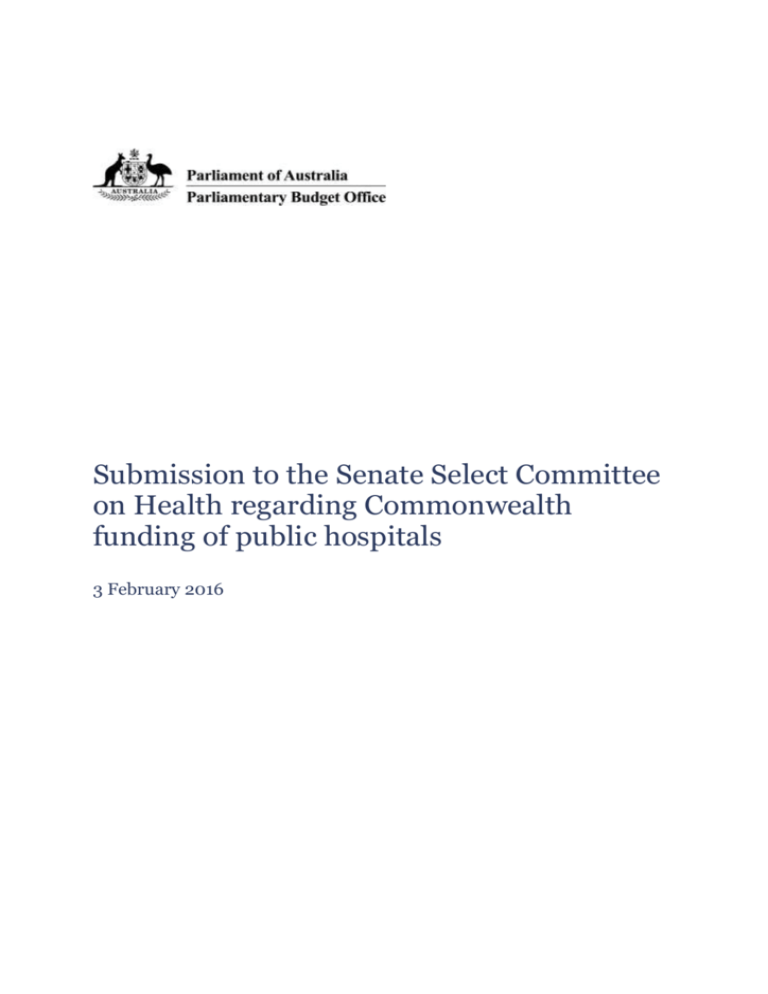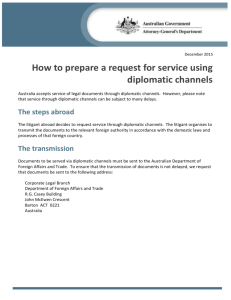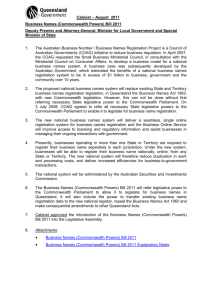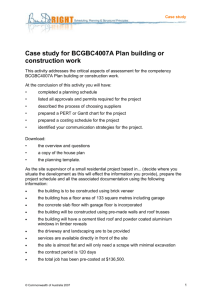1166 KB - Parliament of Australia
advertisement

Submission to the Senate Select Committee on Health regarding Commonwealth funding of public hospitals 3 February 2016 Contents Introduction _______________________________________________________________________________ 3 Background ________________________________________________________________________________ 3 Data Sources _______________________________________________________________________________ 8 Attachment A ______________________________________________________________________________ 9 Attachment B _____________________________________________________________________________ 14 PBO submission to the Senate Select Committee on Health Page 2 of 15 Introduction 1 The Secretary of the Senate Select Committee on Health (the Committee) wrote to the Parliamentary Budget Officer on 16 December 2015 requesting the preparation of a submission to the Committee in relation to Commonwealth funding of public hospitals. A copy of this request is provided at Attachment A. 2 In response to this request the PBO has provided the following information: Table 1 Aggregate and State breakdown of the difference in Commonwealth hospital funding under current Government policy (indexation by Consumer Price Index (CPI) and population growth, see Table B1 at Attachment B) and the scenario where Commonwealth hospital funding was to be provided in accordance with the National Health Reform Agreement 2011 (the 2011 Agreement, see Table B2 at Attachment B),1 over 2014–15 to 2024–25. Table 2 Aggregate and State breakdown of the difference between Commonwealth hospital funding with and without the funding guarantee specified in clauses A67 to A79 of the 2011 Agreement in place, over 2014–15 to 2017–18. Table 3 Aggregate and State breakdown of the difference in Commonwealth funding under current Government policy and the scenario where the National Partnerships terminated in the 2014–15 Budget were still in effect, over 2014–15 to 2024–25. Background National Health Reform 3 On 2 August 2011 the Council of Australian Governments (COAG) agreed to the 2011 Agreement, replacing the former National Healthcare Specific Purpose Payment (SPP). 4 Under the 2011 Agreement, from 1 July 2014 Commonwealth funding for public hospitals would use an activity based funding (ABF) approach with a national efficient price for hospital services. The Commonwealth agreed to meet 45 per cent of the efficient growth in activity based funding initially, rising to 50 per cent after 1 July 2017. 5 The 2011 Agreement also set out an approach for hospital services and functions where block funding was deemed appropriate (such as those provided in rural/small hospitals). As per the ABF approach, the Commonwealth agreed to meet 45 per cent of the efficient growth in block grant funding based on the national efficient cost initially, rising to 50 per cent after 1 July 2017. 1 Note the 2011 Agreement profile used to derive these amounts did not include the funding guarantees. PBO submission to the Senate Select Committee on Health Page 3 of 15 6 Further, the 2011 Agreement provided a guarantee that the Commonwealth funding under the ABF approach would provide at least an additional $16.4 billion in growth in funding between 2014–15 and 2019–20. As such, in the event the ABF approach resulted in additional funding of less than $16.4 billion over the period, the Commonwealth would provide the remainder to States as top-up funding. a Of the $16.4 billion guarantee up to $9.5 billion in top-up funding (referred to as the state specific guarantee) was to be provided to states based on an annual reconciliation of what was provided under the ABF approach and what would have been provided under the former National Health Care SPP. b An assessment of the amount of the remaining top-up funding under the national guarantee ($6.9 billion) was to occur in 2017 at which time decisions regarding the quantum and timing of the remaining guarantee funding would be made (refer to clause A75 of the 2011 Agreement). 7 In May 2015 the Government announced that from 1 July 2017 the Commonwealth’s contribution would grow in line with CPI and population growth. 8 The 2014–15 Budget included two measures ceasing the National Partnership on Preventive Health and the National Partnership on Improving Public Hospital Services. PBO submission to the Senate Select Committee on Health Page 4 of 15 Table 1: PBO projections—Aggregate and State breakdown of the difference in Commonwealth hospital funding under current Government policy (indexation by CPI and population growth) and the scenario where Commonwealth hospital funding was to be provided in accordance with the 2011 Agreement, over 2014–15 to 2024–252 (a)(b)(c)(d)(e)(f) ($m) 2014–15 2015–16 2016–17 2017–18 2018–19 2019–20 2020–21 2021–22 2022–23 2023–24 2024–25 Total New South Wales - - - -371 -801 -1,265 -1,782 -2,359 -2,988 -3,679 -4,436 -17,681 Victoria - - - -272 -589 -952 -1,356 -1,806 -2,298 -2,838 -3,430 -13,541 Queensland - - - -199 -464 -752 -1,074 -1,433 -1,824 -2,254 -2,726 -10,726 Western Australia - - - -168 -308 -474 -658 -863 -1,087 -1,333 -1,602 -6,493 South Australia - - - -103 -206 -312 -429 -559 -701 -858 -1,029 -4,197 Tasmania - - - -20 -53 -83 -117 -154 -195 -240 -289 -1,151 Australian Capital Territory - - - -84 -113 -145 -180 -218 -260 -306 -356 -1,662 Northern Territory - - - -30 -46 -63 -82 -103 -125 -150 -178 -777 Total - - - -1,247 -2,580 -4,046 -5,678 -7,495 -9,478 -11,658 -14,046 -56,228 a The impacts are on a fiscal balance basis. b Figures presented are based on economic and fiscal parameters as at the 2015–16 MYEFO. c Note the 2011 Agreement profile used to derive these amounts did not include the funding guarantees (this is addressed in Table 2). d Amounts may not sum due to rounding. e The aggregate financial implications are considered to be of medium reliability. The estimates for hospital funding under the current policy setting (where growth is based on population and CPI) are considered reliable particularly given that population is relatively stable and has predictable growth. The estimates for hospital funding based on the 2011 Agreement are less reliable as they are based on estimated total hospital expenditure (Commonwealth and state governments) which are less predictable as there is limited historical data (particularly for growth in efficient prices). f The state breakdowns are of medium reliability as the estimates are calculated based on state proportions of the total in the last known year of available data, and the future distribution of the Australian population across states and territories may differ, particularly as the projection period increases. 2 Timeframe as requested by the Committee. PBO submission to the Senate Select Committee on Health Page 5 of 15 Table 2: PBO projections—Aggregate and State breakdown of the difference between Commonwealth hospital funding with and without the funding guarantee specified in clauses A67 to A79 of the 2011 Agreement in place, over 2014–15 to 2017–183 (a)(b)(c)(d)(e) ($m) 2014–15 2015–16 2016–17 2017–18 Total New South Wales - - - - - Victoria - 23 109 3 135 17 92 160 87 356 Western Australia - 43 74 58 174 South Australia - - 21 - 21 Tasmania - - 7 - 7 Australian Capital Territory - 1 1 - 2 Northern Territory - - - - - 17 158 371 148 695 Queensland Total a The impacts are on a fiscal balance basis. b Figures presented are based on economic and fiscal parameters as at the 2015–16 MYEFO. c Amounts may not sum due to rounding. d The aggregate financial implications are considered to be of low reliability. The estimates for the withdrawal of the funding guarantee were derived using the estimates for Commonwealth hospital funding, based on the 2011 Agreement, and estimates for the National Healthcare SPP, and a state breakdown of the funding guarantee amounts outlined in the 2011 Agreement. The reliability of estimates for funding based on the 2011 Agreement are outlined in notes to Table 1, and the estimates for the National Healthcare SPP are slightly more reliable as they are based on the formula specified in the 2009 Intergovernmental Agreement on Federal Financial Relations. As the aggregate implications are dependent on the two series of estimates mentioned, they are rated as low reliability as the margins for error compound. e The state breakdowns are of medium reliability as the estimates are calculated based on state proportions of the total in the last known year of actual data and may differ particularly as the projection period increases. 3 Timeframe as requested by the Committee. PBO submission to the Senate Select Committee on Health Page 6 of 15 Table 3: PBO projections—Aggregate and State breakdown of the difference in Commonwealth funding under current Government policy and the scenario where the National Partnerships terminated in the 2014–15 Budget were still in effect, over 2014–15 to 2024–254 (a)(b)(c)(d) ($m) 2014–15 2015–16 2016–17 2017–18 2018–19 2019–20 2020–21 2021–22 2022–23 2023–24 2024–25 Total New South Wales 17 49 74 42 - - - - - - - 182 Victoria 13 38 56 32 - - - - - - - 139 Queensland 11 32 48 27 - - - - - - - 117 Western Australia 6 16 24 14 - - - - - - - 60 South Australia 4 11 16 9 - - - - - - - 40 Tasmania 1 3 5 3 - - - - - - - 12 Australian Capital Territory 1 2 4 2 - - - - - - - 9 Northern Territory 1 2 3 2 - - - - - - - 6 54 153 230 130 - - - - - - - 567 Total a The impacts are on a fiscal balance basis. b Figures presented are based on economic and fiscal parameters as at the 2015–16 MYEFO. c Amounts may not sum due to rounding. d The aggregate financial implications and state breakdowns are considered to be of high reliability as the amounts are as presented in the 2014–15 Budget and the funding that would be provided under the relevant National Partnerships were fixed amounts and not dependent on population or price factors. 4 Timeframe as requested by the Committee. PBO submission to the Senate Select Committee on Health Page 7 of 15 Data Sources 1 The Department of Finance and the Treasury provided 2015–16 MYEFO parameter and population projections. 2 Commonwealth Budget, MYEFO and Final Budget Outcome documents. 3 Council of Australian Governments National Health Reform Agreement, February 2011: http://www.federalfinancialrelations.gov.au/content/npa/health_reform/nationalagreement.pdf 4 Intergovernmental Agreements on Federal Financial Relations, Schedule D, March 2009: http://www.federalfinancialrelations.gov.au/content/inter_agreement_and_schedules/supers eded/Schedule_D_March_09.pdf 5 Australian Institute of Health and Welfare—Health Expenditure Australia annual publications. PBO submission to the Senate Select Committee on Health Page 8 of 15 Attachment A The Senate Select Committee on Health 16 December 2015 Mrs Phil Bowen PSM FCPA Parliamentary Budget Officer Parliamentary Budget Office By email: pbo@pbo.gov.au Dear Mr Bowen Request for submission – Senate Select Committee on Health I am writing on behalf of the Senate Select Committee on Health. The committee has agreed to request from the Parliamentary Budget Office a submission in relation to Commonwealth funding of public hospitals. The committee has recently held public hearings on this topic in Melbourne, Cairns, Rockhampton, and Sydney.1 Further to the evidence received during these hearings, the secretariat has been researching funding figures for states and territories, particularly for the period 2017–18 to 2024–25 during which Commonwealth funding will change from activity-based funding to block funding indexed to CPI and population growth. There does not appear to be a single comprehensive source of this information. The secretariat’s broad findings are at Attachment A. Drawing information from different sources may create difficulties, including the possibility that groups may be calculating the change in Commonwealth funding differently. In order to obtain reliable information, the committee has agreed to request the following information from the Parliamentary Budget Office: 1. The reductions in Commonwealth hospital funding for 2017–18 to 2024–25 as a result of funding changing to indexation by CPI and population growth (by state) as part of the cancellation of the National Health Reform Agreement (NHRA) 2. The reductions in Commonwealth hospital funding from 2014–15 to 2017-18 caused by the removal of funding guarantees under the NHRA (by state) 3. The reductions in overall Commonwealth health funding between 2014–15 and 2024–25 caused by the cancellation of health-related National Partnership Agreements (by state). Please contact me on 02 6277 3598 if you have any queries regarding this matter. Yours sincerely Stephen Palethorpe Committee Secretary 1 For transcripts from the Committee’s hearings between 4 and 27 November, see the committee’s website: www.aph.gov.au/Parliamentary_Business/Committees/Senate/Health/Health/Public_Hearings PO BOX 6100, Parliament House, Canberra ACT 2600 Tel: (02) 6277 3419 Fax: (02) 6277 5809 Email: health.sen@aph.gov.au Internet: www.aph.gov.au/senate PBO submission to the Senate Select Committee on Health Page 9 of 15 PBO submission to the Senate Select Committee on Health Page 10 of 15 Reduction in Commonwealth hospital funding Estimates of reductions from 2017–181 Queensland: Funding cuts of up to $11.8 billion. In Far North Queensland means losing 42 doctors, 149 nurses, and 42 allied health professionals. New South Wales: Funding cuts of up to $17.7 billion AMA NSW notes that the cuts are equivalent to the loss of ‘five and a half Westmead hospitals’. Australian Capital Territory: Funding cuts of around $1.0 billion. Tasmania: Funding cuts of around $1.0 billion. Victoria: Funding cuts of up to $17.7 billion. These cuts are equivalent to losing two tertiary hospitals. South Australia: Funding cuts of up to $3.5 billion. These cuts are equivalent to closing 600 hospital beds. Western Australia: Funding cuts of up to $5.7 billion. Northern Territory: Funding cuts of around $0.6 billion. Equivalent to 60 hospital beds or one Palmerston Hospital. 1 Information has been taken from a range of sources including evidence presented to the Senate Select Committee on Health, 2015 Intergenerational Report, reports by the AMA, and media reports. PBO submission to the Senate Select Committee on Health Page 11 of 15 Sources Queensland: Evidence from representatives from the Cairns and Hinterland Hospital and Health Service (pp 1-12) and representatives from the Queensland Department of Health (pp 13-24), Committee Hansard, 16 November 2015. South Australia: ‘South Australia’s Response to the 2014–15 Commonwealth Budget Cuts’, South Australian Government, May 2014. See also evidence from representatives of the South Australian Department of Health and Ageing, Committee Hansard, 11 June 2015 (pp 20-28). Victoria: Evidence from representatives from the Victorian Department of Health and Human Services (pp38-48), Committee Hansard, 4 November 2015. New South Wales: AMA NSW, media release, ‘Commonwealth cuts will see NSW lose five-and-a-half Westmead Hospitals’, 23 June 2015. AMA NSW, ‘Pre-Budget Briefing NSW State Budget June 2015’, 9. 5. Northern Territory Chief Minister of the Northern Territory, the Hon Adam Giles MLA, media release, ‘Territory Health and Education Funding Under Threat’, 18 May 2014. http://www.chiefminister.nt.gov.au/media-releases/territory-health-and-education-funding-under-threat Western Australia, Tasmania, Australian Capital Territory 2015 Intergenerational Report, Department of Treasury, 5 March 2015, as quoted by Lenore Taylor, ‘Doctors’ group predicts health funding crisis unless federal cuts are reversed’, The Guardian, 16 April 2015 PBO submission to the Senate Select Committee on Health Page 12 of 15 Supporting information from the 2015 Public Hospital Report Card – An AMA analysis of Australia’s public hospital system, AMA, March 2015. Some figures quoted in the above map are taken from Hansard evidence, while other figures are from the 2015 Intergenerational Report, as quoted by Lenore Taylor writing in The Guardian. The complete set of figures from this source is: QLD NSW VIC SA WA TAS NT ACT $10 billion $16 billion $12 billion $3.5 billion $5.7 billion $1.0 billion $0.6 billion $1.0 billion Figures from other sources, including evidence from public hearings are: QLD NSW VIC SA WA TAS NT ACT $11.8 billion $17.7 billion $17.7 billion $1.0 billion Not available Not available Not available Not available PBO submission to the Senate Select Committee on Health Page 13 of 15 Attachment B Table B1: PBO projections of commonwealth hospital funding under current Government policy (indexation by Consumer Price Index (CPI) and population growth), at an aggregate and state and territory level, over 2014–15 to 2024–255 (a)(b)(c) ($m) 2014–15 2015–16 2016–17 2017–18 2018–19 2019–20 2020–21 2021–22 2022–23 2023–24 2024–25 Total New South Wales 4,878 5,243 5,523 5,755 5,987 6,236 6,491 6,755 7,028 7,312 7,605 68,813 Victoria 3,851 4,134 4,331 4,533 4,734 4,931 5,132 5,341 5,557 5,781 6,013 54,338 Queensland 3,061 3,284 3,451 3,629 3,778 3,935 4,096 4,263 4,435 4,614 4,799 43,345 Western Australia 1,755 1,831 1,956 2,001 2,095 2,182 2,271 2,364 2,459 2,559 2,661 24,134 South Australia 1,125 1,188 1,238 1,270 1,315 1,370 1,426 1,484 1,544 1,606 1,670 15,236 Tasmania 334 349 359 378 388 404 421 438 455 474 493 4,493 Australian Capital Territory 305 321 343 296 308 321 334 347 362 376 391 3,704 Northern Territory 158 174 193 184 191 199 207 215 224 233 243 2,221 15,466 16,525 17,394 18,047 18,796 19,578 20,378 21,207 22,065 22,955 23,875 216,286 Total a The impacts are on a fiscal balance basis. b Figures presented are based on economic and fiscal parameters as at the 2015–16 MYEFO. c Amounts may not sum due to rounding. 5 Timeframe as requested by the Committee. PBO submission to the Senate Select Committee on Health Page 14 of 15 Table B2: PBO projections of scenario where Commonwealth hospital funding was to be provided in accordance with the National Health Reform Agreement 2011, over 2014–15 to 2024–256 (a)(b)(c)(d) ($m) 2014–15 2015–16 2016–17 2017–18 2018–19 2019–20 2020–21 2021–22 2022–23 2023–24 2024–25 Total New South Wales 4,878 5,243 5,523 6,126 6,788 7,501 8,273 9,114 10,016 10,991 12,041 86,494 Victoria 3,851 4,134 4,331 4,805 5,323 5,883 6,488 7,148 7,855 8,619 9,443 67,880 Queensland 3,061 3,284 3,451 3,828 4,242 4,687 5,170 5,695 6,259 6,868 7,525 54,070 Western Australia 1,755 1,831 1,956 2,169 2,403 2,656 2,929 3,227 3,546 3,891 4,263 30,626 South Australia 1,125 1,188 1,238 1,373 1,521 1,681 1,854 2,043 2,245 2,464 2,699 19,431 Tasmania 334 349 359 398 441 487 538 592 651 714 782 5,645 Australian Capital Territory 305 321 343 380 421 466 514 566 622 682 748 5,368 Northern Territory 158 174 193 214 237 262 289 318 350 384 420 2,999 15,466 16,525 17,394 19,294 21,377 23,623 26,055 28,703 31,545 34,613 37,922 272,517 Total a The impacts are on a fiscal balance basis. b Figures presented are based on economic and fiscal parameters as at the 2015–16 MYEFO. c Amounts may not sum due to rounding. d Note these figures exclude ant state specific of national guarantee funding. 6 Timeframe as requested by the Committee. PBO submission to the Senate Select Committee on Health Page 15 of 15 Page 15 of 15









